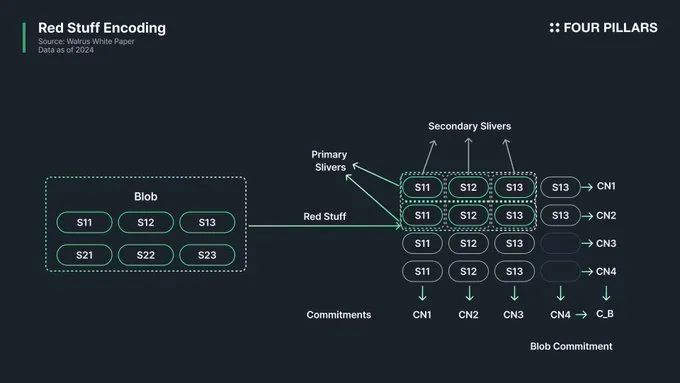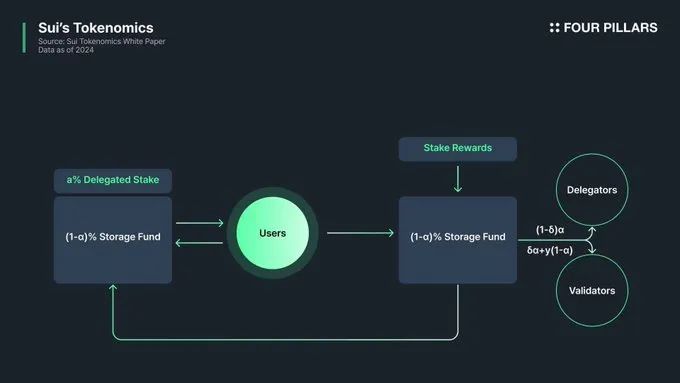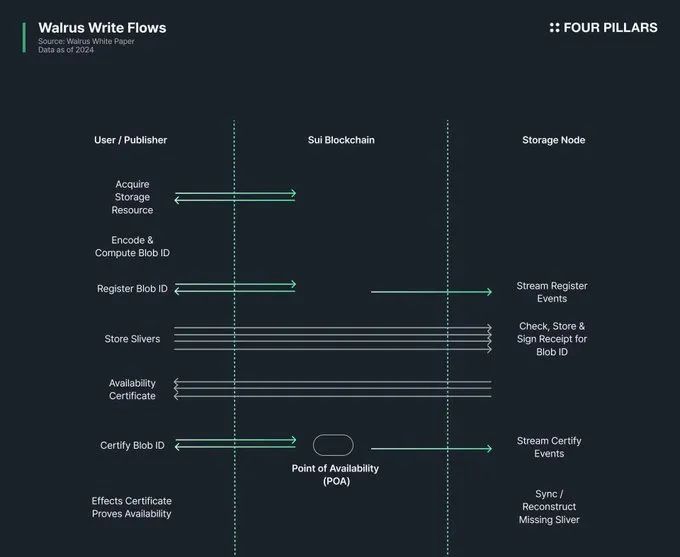Beyond Filecoin? Understand the new protocol developed by the Sui team in one article Walrus

Reprinted from panewslab
02/19/2025·2MThe author of this article: @Steve_4P, the article only represents the author's views.
Summary of key points
- Mysten Labs successfully launched the Sui Network and DeepBook protocols and is now preparing to launch a new project - the Walrus protocol.
- Although there are already many protocols in the decentralized storage market, Walrus has attracted widespread attention with two points: (1) Cost-effectiveness and security: Walrus is more cost-effective and secure than existing storage solutions. (2) Programmability: It enables the stored data to be programmed through the Sui network.
- As one of the most advanced projects in existing decentralized storage protocols, Walrus' practicality and value in the future are worthy of attention.
01 Walrus launch background
Mysten Labs successfully launched the Sui Network and DeepBook protocols, and is now entering a new field - the Walrus protocol. Sui Network and DeepBook’s success has accumulated a lot of expectations for the Walrus project. However, despite the high enthusiasm, there are some doubts surrounding the Walrus protocol.
These concerns stem from several factors: there are already many decentralized storage solutions on the market, many of which have not achieved ideal performance; and there are also concerns about resource allocation – especially whether Mysten Labs will continue to develop and Strengthen the Sui network and disperse resources, affecting the advancement of new projects.
Therefore, we will explore the structure of the Walrus protocol, analyze its differences from existing decentralized storage solutions, and further study the relationship between Walrus and Sui network, focusing on how Walrus integrates with the Sui architecture and enhances the entire Sui ecosystem value.
1. The difference between Walrus and existing storage solutions
To illustrate why Walrus needs to exist, we first need to discuss how it differs from existing decentralized distributed storage solutions. From my point of view, there are three main differences between Walrus and existing storage models (particularly Filecoin and Arweave) that can be summarized as follows:
Storage cost efficiency

First, there are significant differences in storage costs between Walrus, Arweave, and Filecoin. As discussed in the Walrus article by Four Pillars, Arweave uses a system where all nodes must copy and store all data, and Filecoin allows users to decide how many nodes there are to store their data (users can choose to use only one miner to store data. , or spread 100 copies of data into 100 miners. Obviously, the more miners are required to store data, the higher the cost).
By contrast, Walrus uses Red-Stuff encoding to show lower costs than Arweave and Filecoin and is up to 100 times more efficient (compared to Arweave, which requires full network data storage, resulting in up to 500 times more replication costs. , while Walrus only requires 4-5 times the copy). At the same time, the probability of data loss is significantly reduced.
Simply put, Walrus solves the shortcomings of Arweave and Filecoin. Although Arweave has a low probability of data loss, it has a high replication cost; Filecoin provides relatively cheap storage based on user needs, low-cost options may bring higher risk of data loss; while Walrus maintains the cost of replication at the best possible level. Reducing the probability of data loss combines the advantages of both.
Additionally, for Arweave, the cost increases as the number of nodes increases (although not linear) as it encourages all nodes/specified nodes to store as much complete data as possible. By contrast, Walrus only requires one network data transfer, and each node stores part of the data, which actually reduces the burden on individual nodes when the network grows. This structural difference makes Walrus' storage cost significantly more efficient than both Arweave and Filecoin.
Programmability
Although Walrus' efficiency is very important compared to Arweave and Filecoin, the most significant difference between it and existing storage models is "programmability". Traditional storage is just a simple data warehouse, while Walrus implements programmable decentralized storage through the Sui network, giving more functionality to store data.
What if a smart contract can directly reference or trigger data stored in decentralized storage? For example, when casting an NFT, the image file can be stored in Walrus, and its blob data object can be created on the Sui network, connecting it with the NFT object. This solves the problem of "incomplete" of traditional NFTs (traditional NFTs store tokens on the chain, but NFT's artistic metadata is stored off-chain), making NFTs through Walrus a real Web3 asset.
Another example directly related to data storage is that since Walrus' blob data can be stored as Sui objects and controlled through Sui's Move smart contract, the smart contract can transfer the stored data to other users or automatically change ownership. That's why we say that the data in Walrus is programmable.
By contrast, Arweave and Filecoin have very limited dynamic integration with on-chain applications, and can even be said to be nearly impossible. Although Filecoin has added some smart contract capabilities through FVM (Filecoin virtual machine), the ability to modify and control data is still limited, and Walrus is significantly better than these two protocols in terms of programmability.
Data access and deletion
The existing storage protocol has a feature: Once the data is uploaded, it can be accessed by anyone and cannot be deleted. While this feature may be useful for individual users, it presents great limitations for institutions and businesses that need to store sensitive data or need to modify/delete data. Unlike in this case, Walrus allows users to discard or modify their data when needed (this is different from Arweave, whose data cannot be deleted or modified; unlike Filecoin, data deletion is not an active request from the user, but when the contract expires or When the node hosting the data goes offline, the data will be deleted).
Some may be concerned that this conflicts with the immutability principle of blockchain, but it is important to remember that what is removed in Walrus is the blob data. Transaction data that is not related to blob data deletion remains the same, and deleting blob data will not affect the integrity of the blockchain.
Compared with traditional storage, Walrus' enhanced practicality greatly improves its application potential in traditional enterprises and Web2 enterprises, further increasing the market's expectations for its diversity.
2. How Walrus and Sui Networks collaborate
After we discussed the difference between Walrus and existing storage protocols, let’s explore the relationship between Walrus and Sui network. When Mysten Labs announced its preparations for the launch of the Walrus protocol, many people questioned it, believing that “they should focus on Sui, rather than creating another new protocol.” However, just by understanding how Walrus works, it is clear that Walrus is not distracting from the attention to Sui, but should be regarded as a storage stack designed to perfect applications on Sui. In other words, Walrus not only supplements the Sui network from a storage perspective, but also actively affects the governance token SUI of the Sui network, which makes the two inseparable. We will explore this further next.
The symbiotic relationship between Sui and Walrus
In fact, Mysten Labs was very concerned about storage during the early design stage of Sui. Blockchain will inevitably grow during use, which may lead to an increase in transaction fees for Sui network users in the future. Therefore, starting from Sui's early design phase, Mysten Labs proposed a unique storage fund concept to solve Sui's storage challenges.

The Sui Storage Fund operates as follows: The fees submitted by the user to the Sui Verification Node are divided into two parts: 1) Gas fees related to calculations, and 2) storage fees for data storage. Sui charges storage fees in advance when users upload data and transfers these funds to storage funds. The Storage Foundation continuously allocates these funds to the verification nodes while the data is kept stored on the chain. In addition, if the user deletes the data, he/she can receive a refund for the storage fee.
Sui's unique on-chain data storage system produces two effects:
- Users can receive a refund for storage fees when deleting data on the chain, creating an economic incentive to reduce the capacity of distributed ledgers.
- The system solves storage-related sustainability issues by charging storage fees in advance and using them as a reward for future verification nodes.
Although Sui solves sustainability issues through this unique structure, storing large-scale blob data such as media files on the chain is still a burden. At this time, Walrus plays a role - through Walrus storing large-scale blob data and object-managing its metadata on Sui, the data can be programmable without directly storing it on Sui.

In addition, Walrus implements the most distinctive feature compared to other storage protocols through Sui - making stored data programmable and controllable. Ultimately, a symbiotic relationship was established between Sui and Walrus, and both sides made up for each other's shortcomings and created unique advantages.
Walrus makes SUI a deflationary asset
From the example of storage funds, we can see that the Sui network requires a certain amount of SUI as storage fee for storing any object, and Walrus is no exception. When creating a blob data object in Walrus, the SUI will be locked in the storage fund based on the size of the object (referring to the object size of the blob, not the actual size of the blob).
Although some fees can be refunded by deleting data, some fees have a destructive effect, reducing circulation by permanently removing the token. In other words, the more data is stored through Walrus, the more SUI will be permanently locked into the storage fund, forming a virtuous cycle, and the increased use of Walrus leads to a decrease in the circulation of SUI.
In summary, the emergence of Walrus is positive news for Sui Network, both from the network level and the asset level. It is expected that through Walrus, the Sui ecosystem will develop in a more diversified direction.
02 Walrus will become Sui's most critical agreement
1. Not just building a blockchain
When Mysten Labs first started, I thought it was just a company focused on Sui networks. However, after seeing the launch of services like Deepbook and SuiNS, I began to think about what kind of vision Mysten Labs is pursuing. When I met Walrus, I realized that their goal was to build a complete Web3 decentralized infrastructure.
Mysten Labs has a different time horizon when it comes to looking at the industry compared to other companies. They are not just issuing tokens, creating popularity and monetizing quickly; on the contrary, they have a vision to lead innovation in various fields such as execution, storage, consensus and communications, while understanding users’ inertia for Web2 services and creating the one that suits them best UI.
Sui Network Processing Execution and Consensus (evolving through programs like Mysticeti, Pilotfish, and Remora), storage is handled by Walrus, communication is handled by SCION, a next-generation Internet architecture that protects network packets due to its DDoS protection and immunity to routing attacks Being famous - it should be noted that SCION is not created by Mysten Labs, but it will be applied to the Sui network), and the Web2 familiar UI is managed by zkLogin, Stashed, SEAL, and KELP.
If all of these plans are successfully implemented, I believe Mysten Labs can rewrite the existing Web3 paradigm. My initial thoughts were limited, and Mysten Labs wasn't just trying to build a blockchain - they were a team building infrastructure for new networks. Of course, I think Sui is at the heart of the Mysten Labs vision, and other programs are playing complementary roles. The same goes for Walrus, which, in my opinion, is probably the most important protocol among them.
2. Walrus is not limited to Sui ecology
However, Walrus is not limited to Sui ecosystem. Like other storage protocols, Walrus can be used by any third party, not just Sui applications, but may even serve as a powerful alternative to existing storage protocols or as an alternative to other DA layers such as Celestia, EigenDA, Avail.
This availability of Walrus extends the requirements of SUI beyond the Sui network. When Walrus is used, data objects are created on the Sui network, resulting in reduced SUI circulation. In other words, Walrus has the potential to make SUI a more attractive asset by creating external demand (this is not an investment proposal, but a structurally possible scenario). Therefore, Walrus is expected to become a bridge that expands all directions of Sui.
3. Can Walrus surpass Filecoin?
Although it needs to be cautious when comparing the value of a specific protocol, I am very optimistic about the future of Walrus because: 1) it operates much more efficiently than existing storage protocols, and 2) it can perform tasks that existing storage protocols cannot do ( For example, becoming a DA or making stored data programmable), 3) It already has a solid network and user base through the Sui network.
If Walrus is not just the storage layer of the Sui network, but as Mysten Labs envisioned, it could become the leading protocol in the storage field.

 jinse
jinse

 chaincatcher
chaincatcher